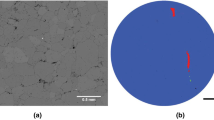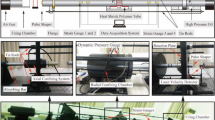Abstract
It is critical to understand the dynamic tensile failure of confined rocks in many rock engineering applications, such as underground blasting in mining projects. To simulate the in situ stress state of underground rocks, a modified split Hopkinson pressure bar system is utilized to load Brazilian disc (BD) samples hydrostatically, and then exert dynamic load to the sample by impacting the striker on the incident bar. The pulse shaper technique is used to generate a slowly rising stress wave to facilitate the dynamic force balance in the tests. Five groups of Laurentian granite BD samples (with static BD tensile strength of 12.8 MPa) under the hydrostatic confinement of 0, 5, 10, 15, and 20 MPa were tested with different loading rates. The result shows that the dynamic tensile strength increases with the hydrostatic confining pressure. It is also observed that under the same hydrostatic pressure, the dynamic tensile strength increases with the loading rate, revealing the so-called rate dependency for engineering materials. Furthermore, the increment of the tensile strength decreases with the hydrostatic confinement, which resembles the static tensile behavior of rock under confining pressure, as reported in the literature. The recovered samples are examined using X-ray micro-computed tomography method and the observed crack pattern is consistent with the experimental result.










Similar content being viewed by others
Abbreviations
- SHPB:
-
Split Hopkinson pressure bar
- BD:
-
Brazilian disc
- CT:
-
Computed tomography
- LG:
-
Laurentian granite
- ISRM:
-
International Society for Rock Mechanics
- \(A_{{{\kern 1pt} {\text{b}}}}\) :
-
Cross-sectional area of the bars (mm2)
- \(A_{{{\kern 1pt} {\text{s}}}}\) :
-
Contact area between the sample and the transmitted bar (mm2)
- \(\sigma_{{{\kern 1pt} 0}}\) :
-
Pump oil pressure (MPa)
- \(\sigma_{{{\kern 1pt} 1}}\) :
-
Stresses of the sample at the transmitted bar end (MPa)
- \(\sigma_{{{\kern 1pt} 2}}\) :
-
Stresses of the sample at the incident bar end (MPa)
- \(\varepsilon_{\text{i}}\) :
-
Incident strain wave
- \(\varepsilon_{\text{r}}\) :
-
Reflected strain wave
- \(\varepsilon_{\text{t}}\) :
-
Transmitted strain wave
- \(P_{1}\) :
-
Force on incident end of the Brazilian disc specimen (N)
- \(P_{2}\) :
-
Force on transmitted end of the Brazilian disc specimen (N)
- \(E_{\text{b}}\) :
-
Young’s modulus of the bars (GPa)
- B :
-
Thickness of the Brazilian disc specimen (mm)
- D :
-
Diameter of the Brazilian disc specimen (mm)
- \(\sigma\) :
-
Tensile stress at the center of the Brazilian disc specimen (MPa)
- S :
-
Dynamic tensile strength of the Brazilian disc specimen (MPa)
- S 0 :
-
Static Brazilian tensile strength of Laurentian granite (MPa)
- P :
-
Hydrostatic pressure of the Brazilian disc samples before impact (MPa)
- P 0 :
-
Reference hydrostatic pressure (1 MPa)
- \(\dot{\sigma }\) :
-
Loading rate of the dynamic test (GPa/s)
- \(\dot{\sigma }_{0}\) :
-
Reference loading rate (1 GP/s)
- \(\alpha\) :
-
Fitting parameter for the tensile strength versus hydrostatic pressure
- \(\beta\) :
-
Fitting parameter for the tensile strength versus loading rate
- n :
-
Fitting parameter for the tensile strength versus loading rate
References
Aadnoy BS, Angellolsen F (1995) Some effects of ellipticity on the fracturing and collapse behavior of a borehole. Int J Rock Mech Min 32:621–627. doi:10.1016/0148-9062(95)00016-A
Bordia SK (1971) Effects of size and stress concentration on dilatancy and fracture of rock. Int J Rock Mech Min Sci 8:629–640. doi:10.1016/0148-9062(71)90031-3
Brar NS, Rosenberg Z (1988) Brittle failure of ceramic rods under dynamic compression. J Phys Paris 49:607–612. doi:10.1051/jphyscol:1988385
Chen R, **a K, Dai F, Lu F, Luo SN (2009) Determination of dynamic fracture parameters using a semi-circular bend technique in split Hopkinson pressure bar testing. Eng Fract Mech 76:1268–1276. doi:10.1016/j.engfracmech.2009.02.001
Christen RJ, Swanson SR, Brown WS (1972) Split-Hopkinson-bar tests on rock under confining pressure. Exp Mech 12:508–513
Cusatis G (2011) Strain-rate effects on concrete behavior. Int J Impact Eng 38:162–170. doi:10.1016/j.ijimpeng.2010.10.030
Dai F, Chen R, **a K (2010a) A semi-circular bend technique for determining dynamic fracture toughness. Exp Mech 50:783–791. doi:10.1007/s11340-009-9273-2
Dai F, Huang S, **a K, Tan Z (2010b) Some fundamental issues in dynamic compression and tension tests of rocks using split Hopkinson pressure bar. Rock Mech Rock Eng 43:657–666. doi:10.1007/s00603-010-0091-8
Dai F, **a K, Zuo JP, Zhang R, Xu NW (2013) Static and dynamic flexural strength anisotropy of Barre granite. Rock Mech Rock Eng 46:1589–1602. doi:10.1007/s00603-013-0390-y
Darma IS, Sugiyama T, Promentilla MAB (2013) Application of X-Ray CT to study diffusivity in cracked concrete through the observation of tracer transport. J Adv Concr Technol 11:266–281. doi:10.3151/jact.11.266
Elyeznasni N, Sellami F, Pot V, Benoit P, Vieuble-Gonod L, Young I, Peth S (2012) Exploration of soil micromorphology to identify coarse-sized OM assemblages in X-ray CT images of undisturbed cultivated soil cores. Geoderma 179:38–45. doi:10.1016/j.geoderma.2012.02.023
Frew DJ, Forrestal MJ, Chen W (2002) Pulse sha** techniques for testing brittle materials with a split Hopkinson pressure bar. Exp Mech 42:93–106. doi:10.1007/BF02411056
Frew DJ, Akers SA, Chen W, Green ML (2010) Development of a dynamic triaxial Kolsky bar Meas. Sci Technol 21:105704–105710
Fujikake K, Senga T, Ueda N, Ohno T, Katagiri M (2006) Effects of strain rate on tensile behavior of reactive powder concrete. J Adv Concr Technol 4:79–84. doi:10.3151/Jact.4.79
Fukuda D, Maruyama M, Nara Y, Hayashi D, Ogawa H, Kaneko K (2014) Observation of fracture sealing in high-strength and ultra-low-permeability concrete by micro-focus X-ray CT and SEM/EDX. Int J Fract 188:159–171. doi:10.1007/s10704-014-9952-6
Garbout A, Munkholm LJ, Hansen SB (2013) Temporal dynamics for soil aggregates determined using X-ray CT scanning. Geoderma 204:15–22. doi:10.1016/j.geoderma.2013.04.004
Hapca S, Baveye PC, Wilson C, Lark RM, Otten W (2015) Three-dimensional map** of soil chemical characteristics at micrometric scale by combining 2D SEM-EDX data and 3D X-Ray CT images. PLoS ONE. doi:10.1371/journal.pone.0137205
Henry M, Darma IS, Sugiyama T (2014) Analysis of the effect of heating and re-curing on the microstructure of high-strength concrete using X-ray CT. Constr Build Mater 67:37–46. doi:10.1016/j.conbuildmat.2013.11.007
Huang S, **a KW (2015) Effect of heat-treatment on the dynamic compressive strength of Longyou sandstone. Eng Geol 191:1–7. doi:10.1016/j.enggeo.2015.03.007
Huang S, Chen R, **a K (2010) Quantification of dynamic tensile parameters of rocks using a modified Kolsky tension bar apparatus. J Rock Mech Geotech Eng 2:162–168. doi:10.3724/SP.J.1235.2010.00162
Huang S, **a K, Zheng H (2013) Observation of microscopic damage accumulation in brittle solids subjected to dynamic compressive loading. Rev Sci Instrum. doi:10.1063/1.4821497
Iqbal N, Mohanty B (2006) Experimental calibration of stress intensity factors of the ISRM suggested cracked chevron-notched Brazilian disc specimen used for determination of mode-I fracture toughness. Int J Rock Mech Min Sci 43:1270–1276. doi:10.1016/j.ijrmms.2006.04.014
Ito F, Nakahara F, Kawano R, Kang SS, Obara Y (2001) Visualization of failure in a pull-out test of cable bolts using X-ray CT. Constr Build Mater 15:263–270. doi:10.1016/S0950-0618(00)00075-1
Jaeger JC, Hoskins ER (1966) Rock failure under confined Brazilian test. J Geophys Res 71:2651–2659
Jia Q, Schmitt DR (2014) Effects of formation anisotropy on borehole stress concentrations: implications to drilling induced tensile fractures. In: Paper presented at the 48th US Rock Mechanics/Geomechanics Symposium, Minneapolis, Minnesota, June 1–4
Lindholm US, Yeakley LM, Nagy A (1974) Dynamic strength and fracture properties of Dresser basalt. Int J Rock Mech Min Sci 11:181–191
Liu T, Zhang XN, Li Z, Chen ZQ (2014a) Research on the homogeneity of asphalt pavement quality using X-ray computed tomography (CT) and fractal theory. Constr Build Mater 68:587–598. doi:10.1016/j.conbuildmat.2014.06.046
Liu XJ, Zhu HL, Liang LX (2014b) Digital rock physics of sandstone based on micro-CT technology Chinese. J Geophys Chin Ed 57:1133–1140. doi:10.6038/cjg20140411
Masad E, Kassem E (2009) Improving the field compaction of asphalt pavements using X-ray CT and imaging techniques. In: Efficient transportation and pavement systems: characterization, mechanisms, simulation, and modeling. Taylor & Francis Group, London, pp 611–620. doi:10.1201/9780203881200.ch57
Otani J, Miyamoto K, Mukunoki T, Hirai T (2001) Visualization of interaction behavior between soil and reinforcement using X-ray CT. In: Landmarks in earth reinforcement, vol 1: Proceedings of the International Symposium on Earth Reinforcement, Fukuoka, Kyushi, Japan. CRC Press, London, pp 117–120
Sugawara K, Fukahori D, Iwatani I, Ikutake T, Kubota S (2004) Analysis of wetting process of rock by means of X-ray CT. In: Otani J, Obara Y (eds) X-ray CT for geomaterials: soils, concrete, rocks. Swets & Zeitlinger, Lisse, pp 315–334
Taniguchi S, Nishizaki I, Ogawa K, Otani J (2012) New X-ray CT evaluation method of engineering characteristics of asphalt mixture. In: Advances in transportation geotechnics II: Proceedings of the 2nd International Conference on Transportation Geotechnics, Hokkaido, Japan. CRC Press, London, pp 400–406
Tatone BSA, Grasselli G (2015) Characterization of the effect of normal load on the discontinuity morphology in direct shear specimens using X-ray micro-CT. Acta Geotech 10:31–54. doi:10.1007/s11440-014-0320-5
Tomoto T, Moriyoshi A (2009) Evaluation of damage to asphalt pavements using a Micro-focus CT scanner and three-dimensional crack analysis. Road Mater Pavement 10:519–543. doi:10.3166/Rmpd.10.519-543
Vervoort A, Wevers M, Swennen R, Roels S, Van Geet M, Sellers E (2004) Recent advances of X-ray CT and its applications for rock material. In: Otani J, Obara Y (eds) X-ray CT for geomaterials: soils, concrete, rocks. Swets & Zeitlinger, Lisse, pp 79–91
Wu B, Kanopoulos P, Luo X, **a K (2014) An experimental method to quantify the impact fatigue behavior of rocks. Meas Sci Technol 25:Artn 075002. doi:10.1088/0957-0233/25/7/075002
Wu B, Chen R, **a K (2015) Dynamic tensile failure of rocks under static pre-tension. Int J Rock Mech Min Sci 80:12–18. doi:10.1016/j.ijrmms.2015.09.003
**a K, Nasseri MHB, Mohanty B, Lu F, Chen R, Luo SN (2008) Effects of microstructures on dynamic compression of Barre granite. Int J Rock Mech Min Sci 45:879–887. doi:10.1016/j.ijrmms.2007.09.013
Zhang QB, Zhao J (2013) A review of dynamic experimental techniques and mechanical behavior of rock materials. Rock Mech Rock Eng 47:1411–1478. doi:10.1007/s00603-013-0463-y
Zhang JT, Liu LS, Zhai PC, Zhang QJ (2008) Experimental and numerical researches of dynamic failure of a high strength alumina/boride ceramic composite. Key Eng Mat 368–372:713–716
Zhang MW, Shimada H, Sasaoka T, Matsui K, Dou LM (2014) Evolution and effect of the stress concentration and rock failure in the deep multi-seam coal mining Environ. Earth Sci 72:629–643. doi:10.1007/s12665-013-2985-8
Zhou YX et al (2012) Suggested methods for determining the dynamic strength parameters and mode-I fracture toughness of rock materials. Int J Rock Mech Min Sci 49:105–112. doi:10.1016/j.ijrmms.2011.10.004
Zhou Z, Li X, Zou Y, Jiang Y, Li G (2014) Dynamic Brazilian tests of granite under coupled static and dynamic loads. Rock Mech Rock Eng 47:495–505. doi:10.1007/s00603-013-0441-4
Acknowledgments
This work has been supported by the Innovative Research Groups of Natural Science Foundation of China (NSFC) under Grant #51321065 and NSFC Grant #51479131. K. X.’s research was partially supported by the Natural Sciences and Engineering Research Council of Canada (NSERC) through the Discovery Grant # 72031326. We would also like to thank Prof. Giovanni Grasselli at the University of Toronto for the access to his X-ray micro-CT scanning system.
Author information
Authors and Affiliations
Corresponding author
Rights and permissions
About this article
Cite this article
Wu, B., Yao, W. & **a, K. An Experimental Study of Dynamic Tensile Failure of Rocks Subjected to Hydrostatic Confinement. Rock Mech Rock Eng 49, 3855–3864 (2016). https://doi.org/10.1007/s00603-016-0946-8
Received:
Accepted:
Published:
Issue Date:
DOI: https://doi.org/10.1007/s00603-016-0946-8




